The ultimate school lunch guide on how to pack Japanese-style Bento in 15 minutes every morning. I’ll show you every step of the way with useful tips and secrets I’ve learned throughout the years!
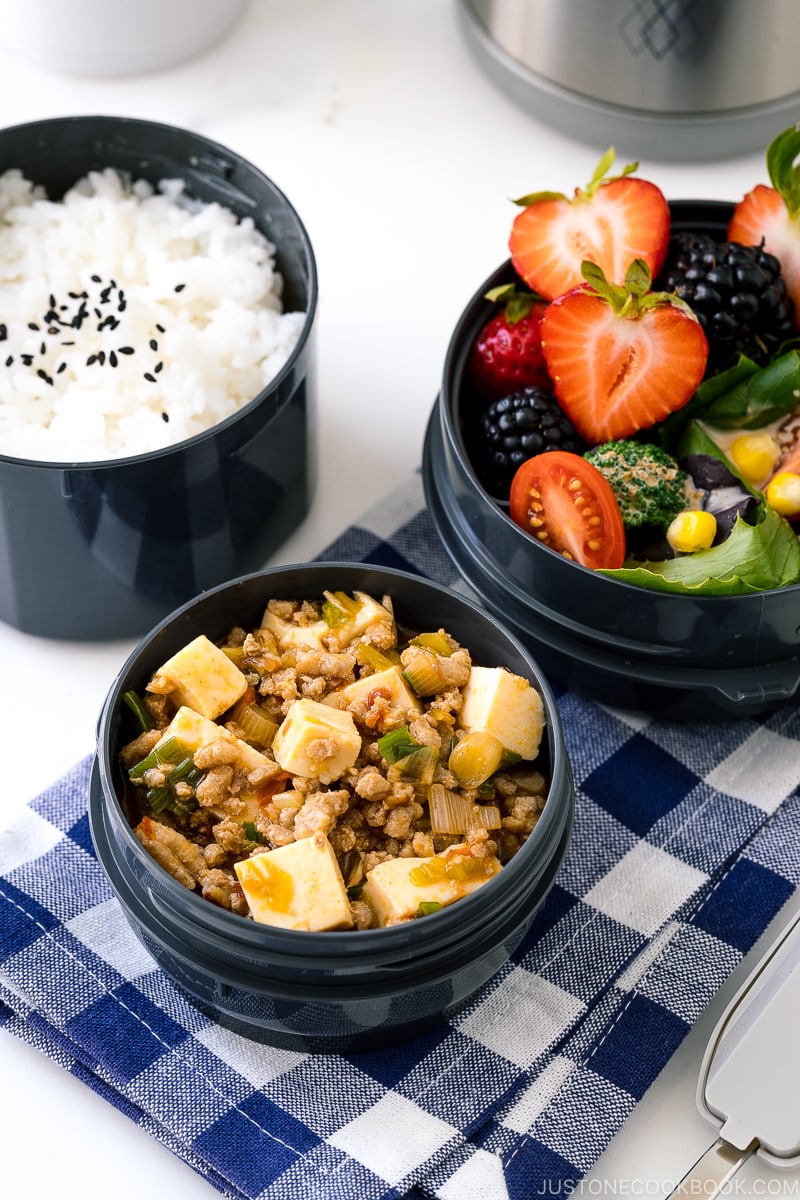
How are you handling your children’s back to school? This time of year I often receive questions from parents about their struggles on packing lunches for their children. But I love that you are all eager to learn how to pack a kid’s lunch like a Japanese-style bento!
If you’re feeling:
- overwhelmed with the whole idea of packing lunch…
- at lost and don’t know where to start…
- discouraged because bento making looks time-consuming and difficult…
I hear you, and many JOC readers feel the same way. 🤗
I started packing my own lunch in junior high school (middle school) and continued throughout high school and college in Japan. My mom prepared the majority of the dishes and I was responsible to pack them into the bento box myself. After I came to the US, I sometimes packed my own bento for work and now I’ve been making kids’ bento since they were in elementary school.
It’s a long time of bento making, yet I still feel overwhelmed sometimes. The good news is I’ve learned to count on a formula that works, and I’m excited to share it with you. Once you get the hang of it, bento-making will become second nature to you.
In this post, I’ll go through my bento planning, prepping, and actual packing process. As a bonus, I’ll show you 6 real-life bento boxes using Zojirushi Vacuum Insulated Lunch Jars that I use for my children.
Ready to jump into the bento-making journey? Let’s begin!
Table of Contents
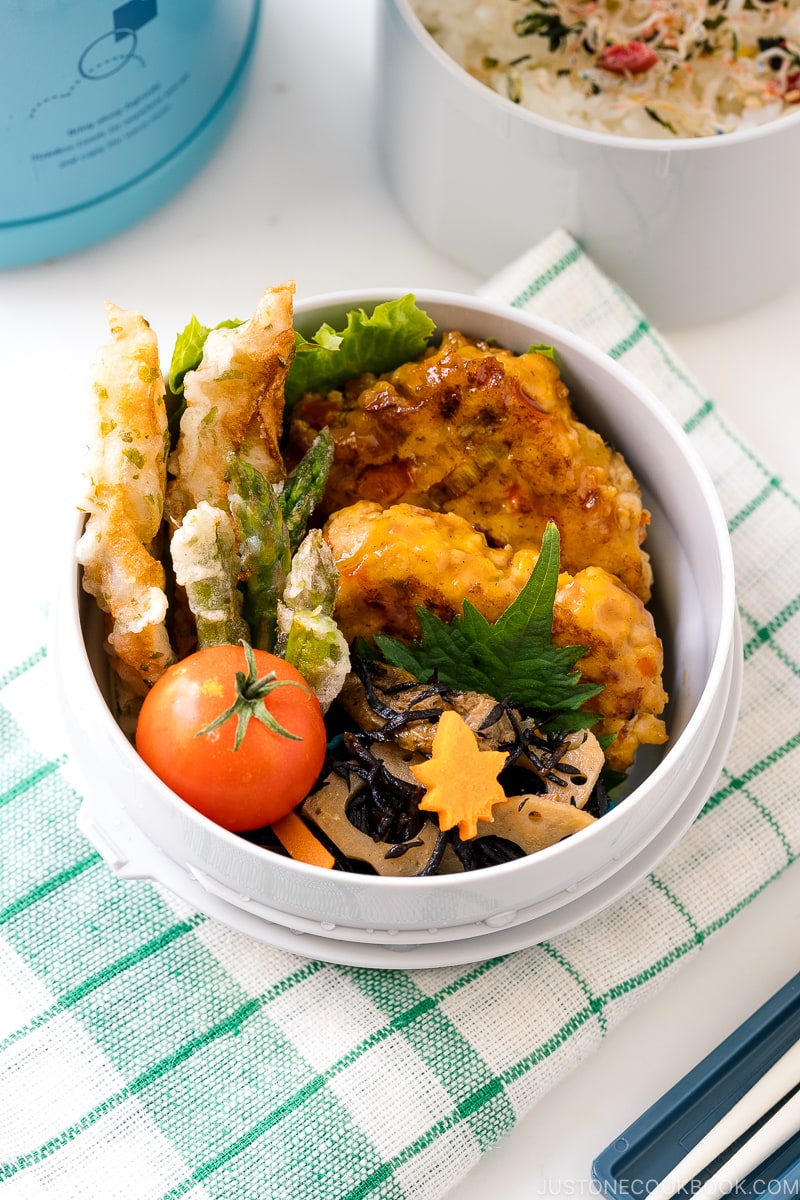
Chapter 1: Plan Bento Menus
Plan what to put in the bento box (Lunch Jar). Since I mostly cook Japanese food at home and this website focuses on Japanese recipes, I will be focusing on packing Japanese dishes here.
If you cook non-Japanese dishes, that’s okay. This post still gives you general ideas and tips on how to pack your own dishes.
📝 Prepare 5 Types of Foods
First, you will need a broad imagination of how your bento should look like. Let’s say this is just an ideal version. There are 5 types of foods you want to pack in your bento.
- Carbs. This is to fill up the tummy! Think of rice, yakisoba, yaki udon, and takikomi gohan.
- Main. Proteins such as meat, fish, and seafood, and tofu. Karaage, gyoza, and teriyaki salmon.
- Sides. Vegetables, tofu, egg, or mushroom dishes. Hijiki salad, potato salad, tamagoyaki, green bean gomaae, and kinpira renkon.
- Fillers. Colorful add-on ingredients to brighten the bento. Blanched broccoli, cherry tomatoes, and boiled egg.
- Fruits. Put it in the bento box or in a separate container. Berries, grapes, apples, and oranges.
💁🏻♀️ Tip: Remember, I only spend 15-20 minutes in the morning packing a bento. I count on leftovers and meal prep dishes from the refrigerator and freezer. This is the only way to pack bento in 15 minutes and stay stress-free.
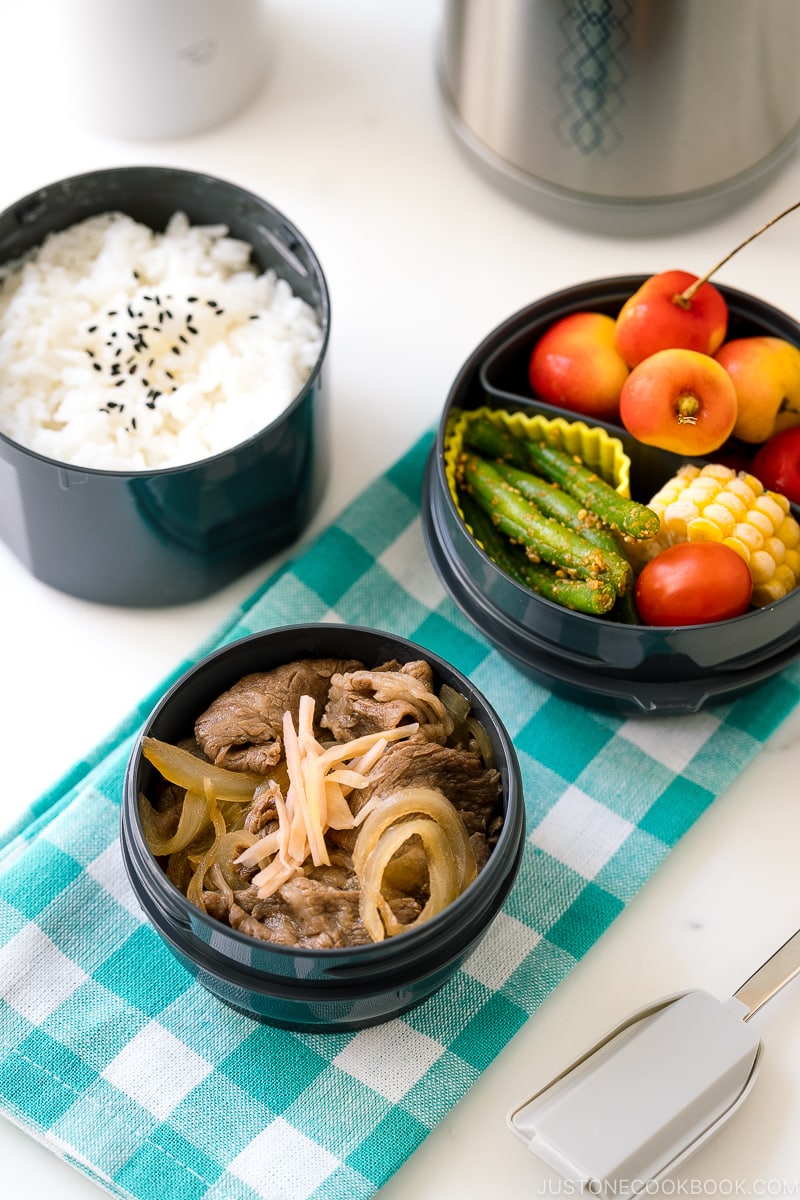
Chapter 2: Meal Prep for Bento
A nice-looking bento doesn’t magically appear without you putting in the effort. So it comes down to when and how to do this efficiently. For me, I don’t want to wake up early… so I make sure to use my effort strategically.
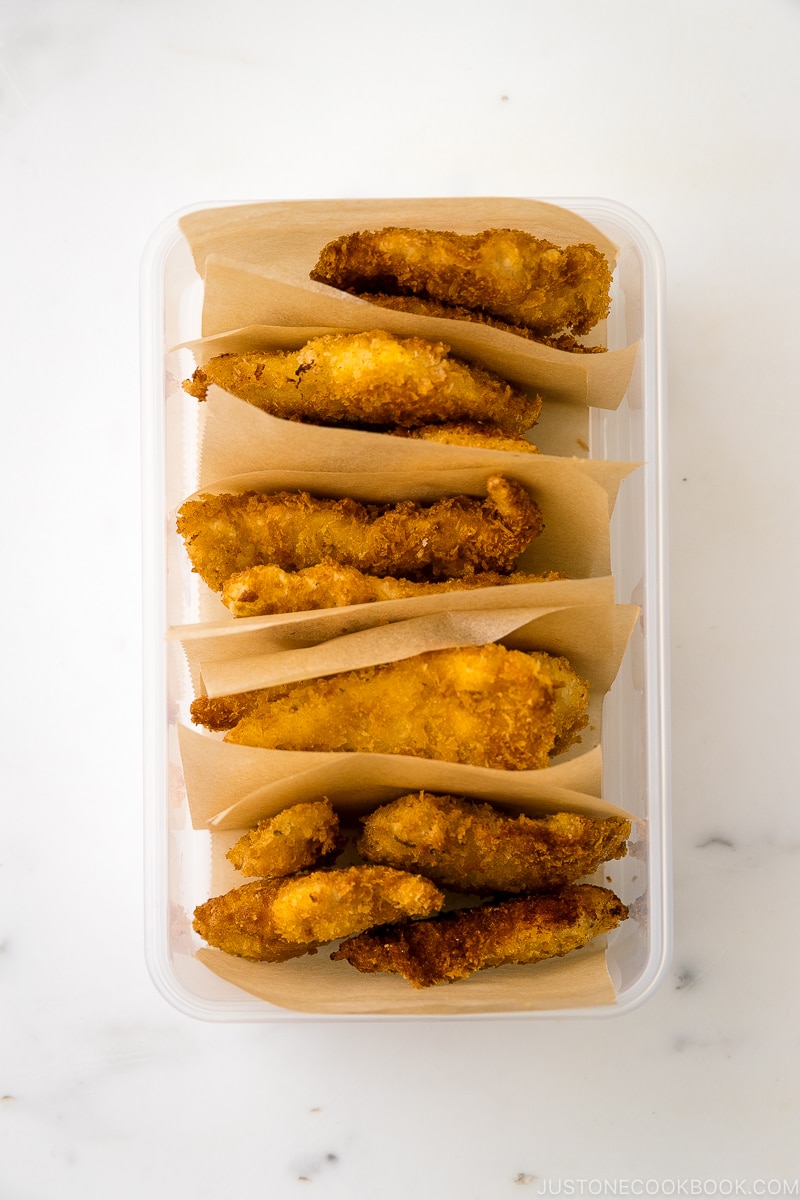
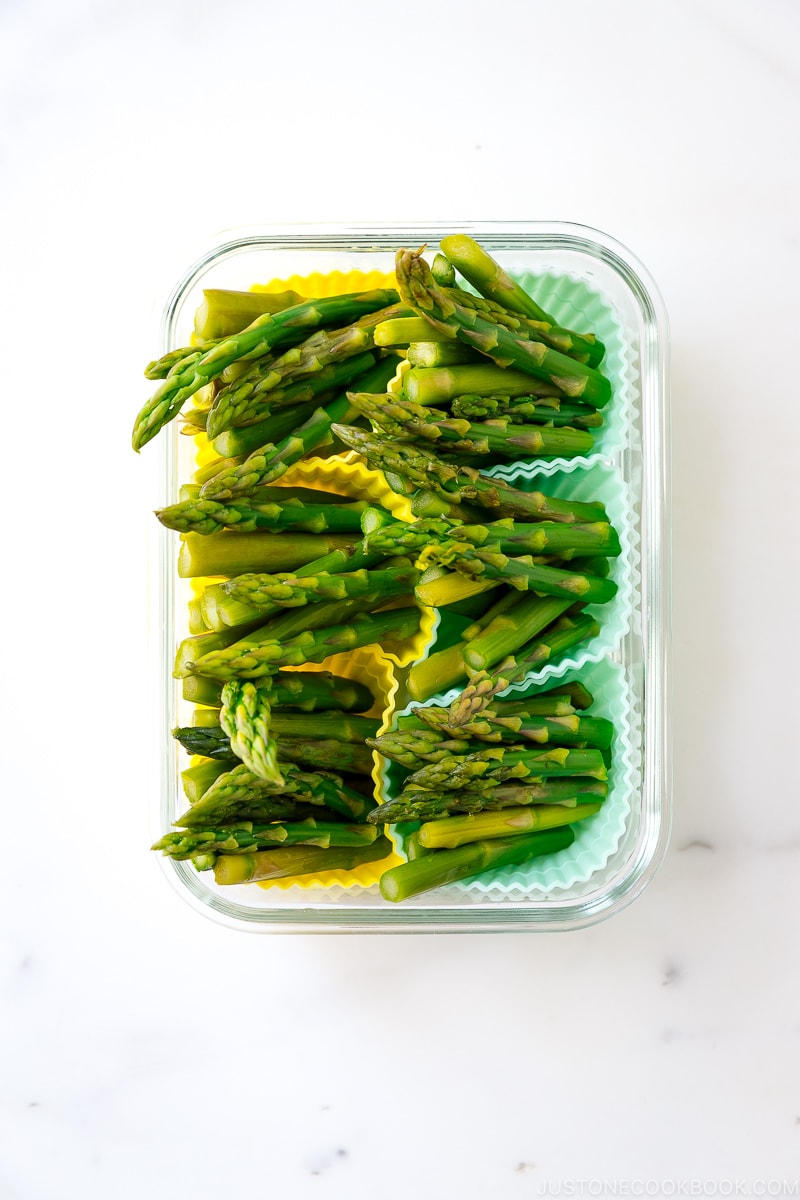
- Make Extra Food and Freeze. When I cook a freezer-friendly dish for dinner, I always make extra. Extra food can be reheated and packed in the bento the next day, or freeze it for later use. Trust me, making extra is a lot less work than starting a new dish from scratch. Don’t forget to date the container when you pack the food. In general, food lasts 2-4 weeks in the freezer.
- Blanch Vegetables and Freeze. Blanch vegetables like broccoli, asparagus, green beans, and corn when I have 5 minutes to spare in the kitchen (usually while cooking dinner). Freeze the cooled, plain vegetables. We can pack the frozen vegetables in the bento directly, or you can thaw them overnight in the fridge and quickly pan-fry or dress them with sauce or dressing in the morning. These blanched veggies are a great filler; they are colorful and give a fresh look. Since Japanese main dishes tend to be brown, these fillers pop up and make the lunch box more appealing.
- Utilize store-bought frozen food. I always have frozen gyoza in my freezer. It is helpful while you build your frozen meal-prepped food or when your inventory is low.
Here’s How to Freeze Food for Bento and keep this List of Meal Prep Freezer-Friendly Dishes for bento-friendly dish ideas!
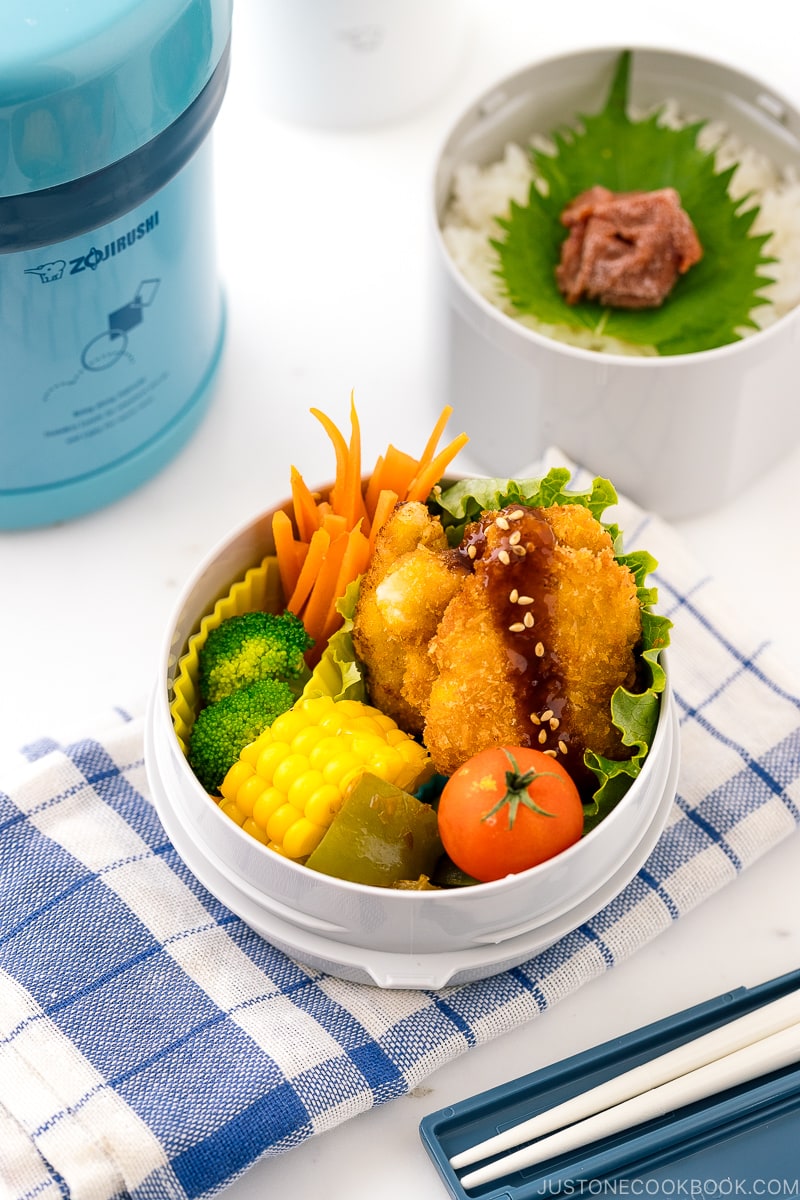
Chapter 3: Food Safety
But before we start packing, let’s talk quickly about food safety (or read more here).
Food Safety Tips:
- Wash your hands and make sure your lunch jars are clean and dry.
- Use clean utensils (chopsticks etc) or plastic gloves when you handle the food. Your hands have germs and it’s better to avoid touching them with your hands.
- Reheat pre-cooked/leftover food/frozen food to eliminate bacteria before packing. The longer the food has been lying around, the less fresh it gets, even when you keep it in the refrigerator or freezer. Use less power on the microwave and heat it thoroughly so it’s reheated properly inside and out.
- Quickly let cool completely. Bacteria love a warm and moist environment, so it’s important to cool the foods from hot to cold as soon as possible. You can use an ice pack underneath the plate or silicone cups so the hot food gets cool fast. If you have an insulated lunch container, pack the hot food immediately and close the lid.
- Pack ice packs in the lunch bag to keep food fresh and safe till lunchtime.
It’s better to take extra safety precautions, especially during the summer months or if you live in a humid or hot climate.
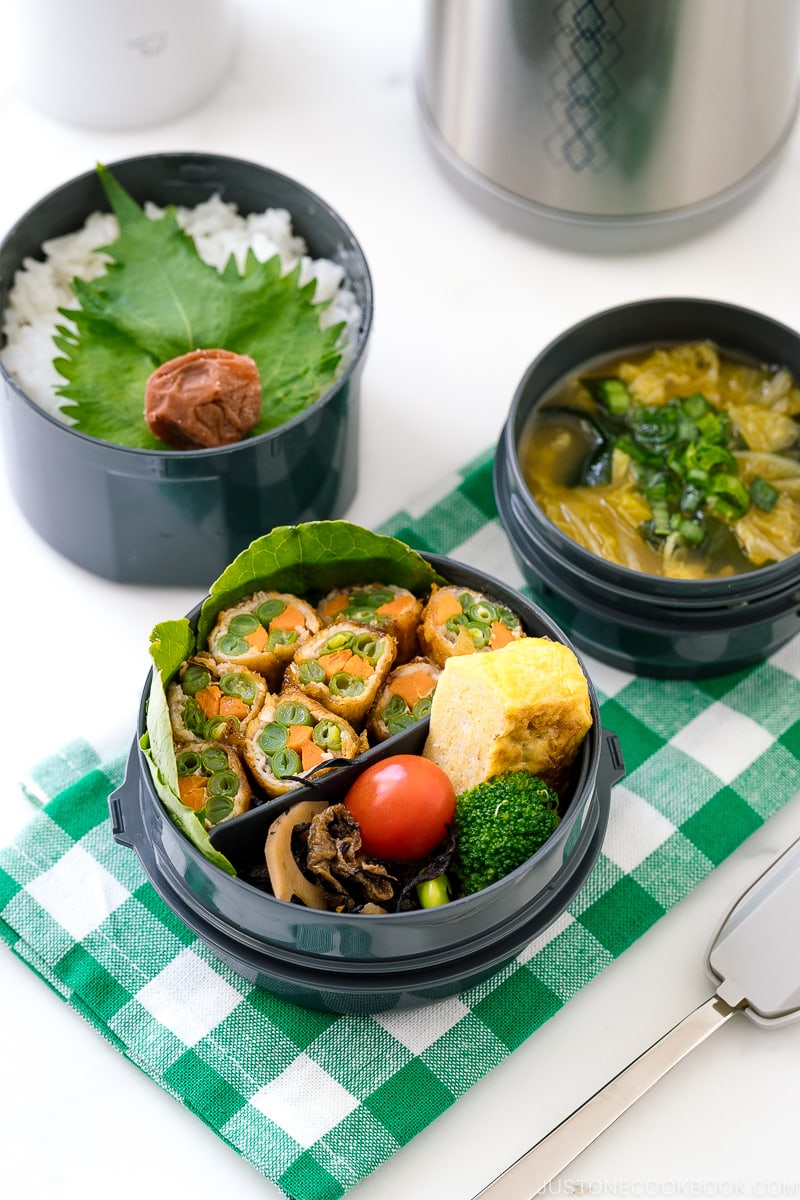
Chapter 4: Pack Bento in the Morning
Now your freezer is packed with an assortment of bento dishes and you are aware of all the food safety tips. What do you do when you wake up? Your freezer is like a buffet or cafeteria. You can find what you want to pack in the bento and get started.
Morning Timeline
- Cook the one dish you decide to prepare (optional).
- Reheat frozen food including frozen steamed rice (if you’re not sure why we reheat, read Food Safety Tip section).
- Pack hot food immediately into a thermal container (if you are using any)
- Let the food cool completely before packing it into a bento box.
- Pack all the cooled bento dishes in the bento box and add “fillers” (frozen or defrosted) if there is any gap.
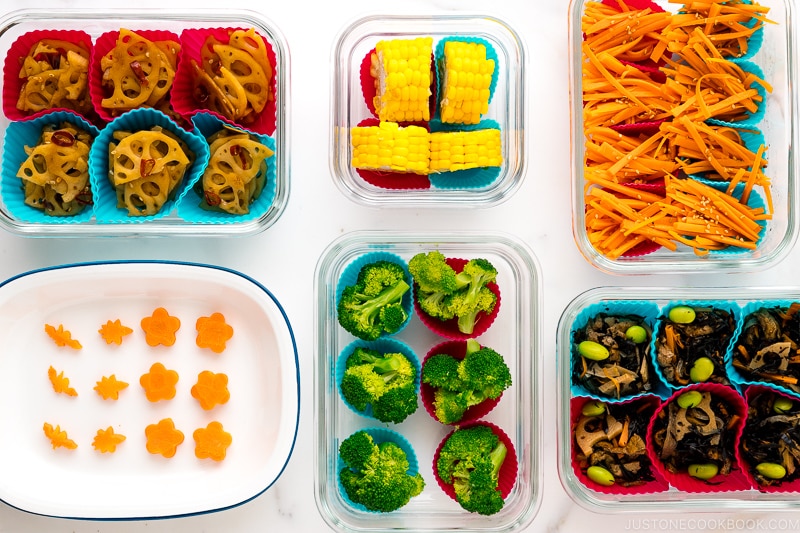
Bento Packing Tips
- Use colorful and microwave-safe silicone cups. They are the easiest way to keep dishes portioned (not stuck to each other), reheated, and packed. Plus, they make bento a more appealing lunch by adding a nice pop of color, especially when you lack colorful veggies. You can purchase these silicone cups and mini ones.
- Pack bulky and big dishes first. The main dish tends to be the biggest item that goes into the bento box. So start with that, followed by the side dish(es) in a silicone cup. Any gap can be filled with vegetable “fillers” such as cherry tomato and blanched broccoli.
- Pack tightly! Otherwise, the dishes would be shifting left and right or up and down!
- Remove liquid. The liquid may go into another dish and mix up all the flavors. Also, the liquid could spoil the food faster, so it’s best for food safety as well.
Chapter 5: Six Real-Life Beonto Examples
I usually pack Japanese-style bento on Monday, Wednesday, and Friday, and pack sandwiches on Tuesday and Thursday to mix things up. But here I made 6 Japanese-style bento.
Monday: Chicken Katsu Bento
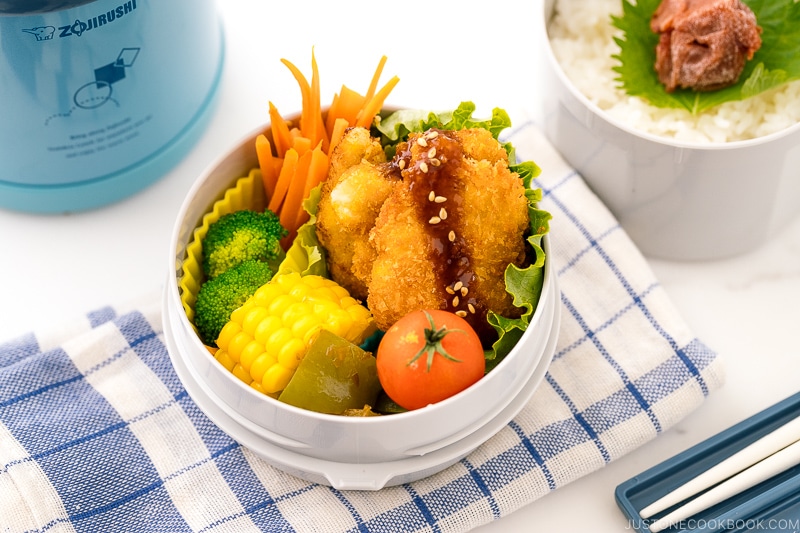
- Carbs: Steamed rice (frozen → reheat in the microwave) with shiso leaf and umeboshi
- Main: Chicken Katsu (frozen → reheat in the toaster oven)
- Sides: Carrot Namul (frozen → thaw in bento box), green bell pepper with bonito flakes (frozen → thaw in bento box)
- Fillers: Blanched broccoli (refrigerated), boiled corn (frozen → thaw in bento box), cherry tomato
- Fruits: In another container
Tuesday: Gyudon Bento
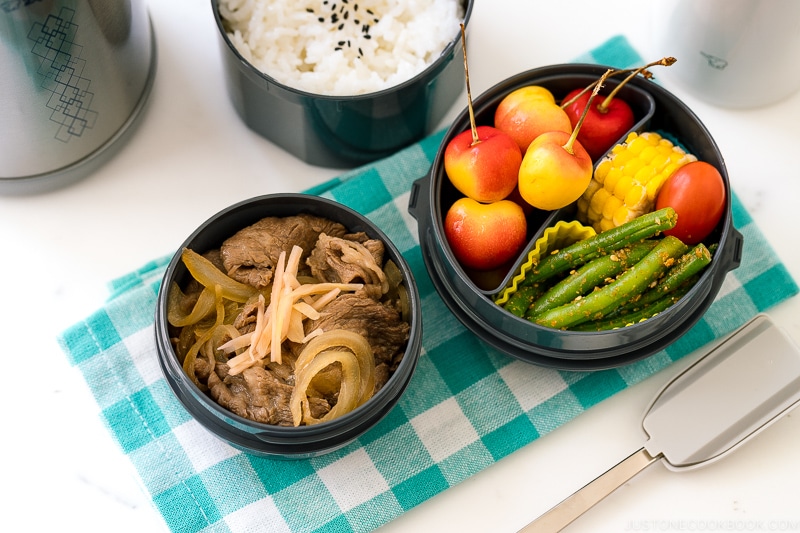
- Carbs: Steamed Rice (frozen → reheat in the microwave) with black sesame seeds
- Main: Gyudon (frozen → reheat in the microwave)
- Sides: Green Bean Gomaae (frozen → thaw in fridge overnight)
- Fillers: Boiled corn (frozen → thaw in bento box), cherry tomato
- Fruits: Cherries
Wednesday: Teriyaki Chicken Meatball Bento
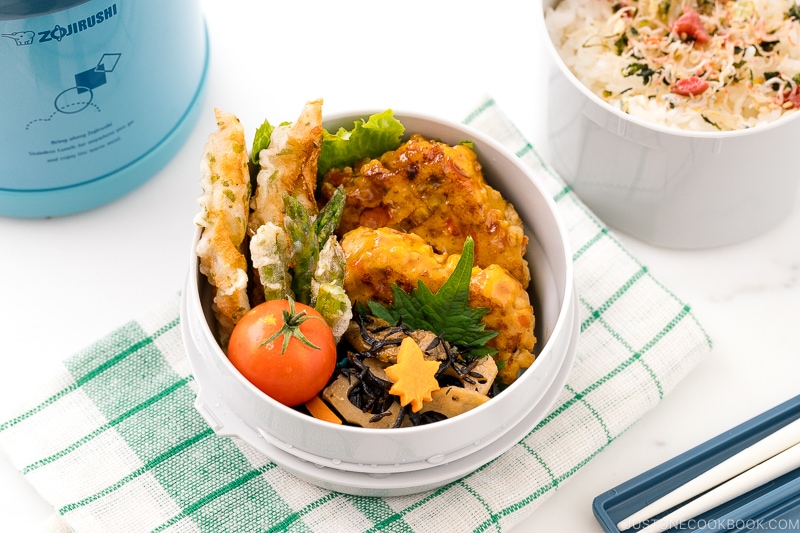
- Carbs: Steamed Rice (frozen → reheat in the microwave) with furikake rice seasoning
- Main: Teriyaki Chicken Meatballs (frozen → reheat in the microwave)
- Sides: Hijiki Salad (frozen → thaw in fridge overnight)
- Fillers: Chikuwa Isobeage (fried in the morning), aspragus tempura (fried in the morning), cherry tomato
- Fruits: In another container
Thursday: Pork Roll Bento
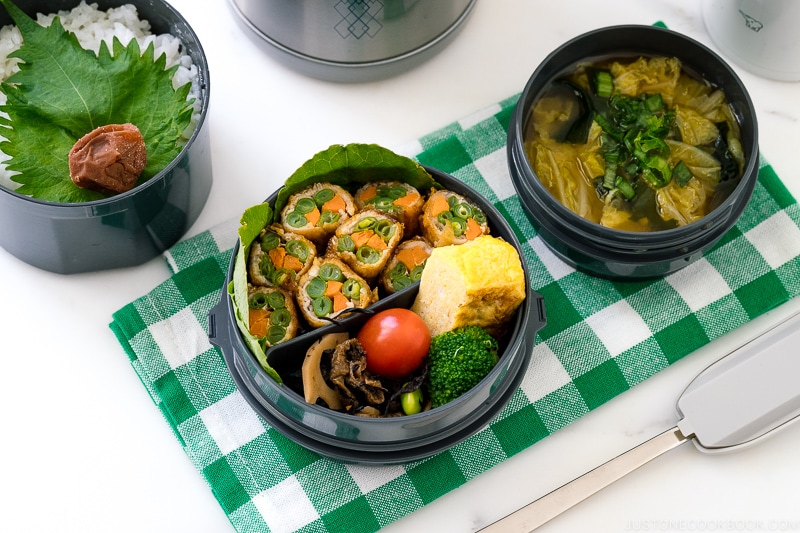
- Carbs: Steamed Rice (frozen → reheat in the microwave) with shiso leaf and umeboshi
- Main: Teriyaki Pork Rolls (frozen → reheat in the microwave)
- Sides: Miso Soup (leftover → reheat in the microwave), Tamagoyaki (frozen → thaw in bento box), Hijiki Salad (frozen → thaw in fridge overnight),
- Fillers: Blanched broccoli (frozen → thaw in bento box), a cherry tomato
- Fruits: In another container
Friday: Gyoza Bento
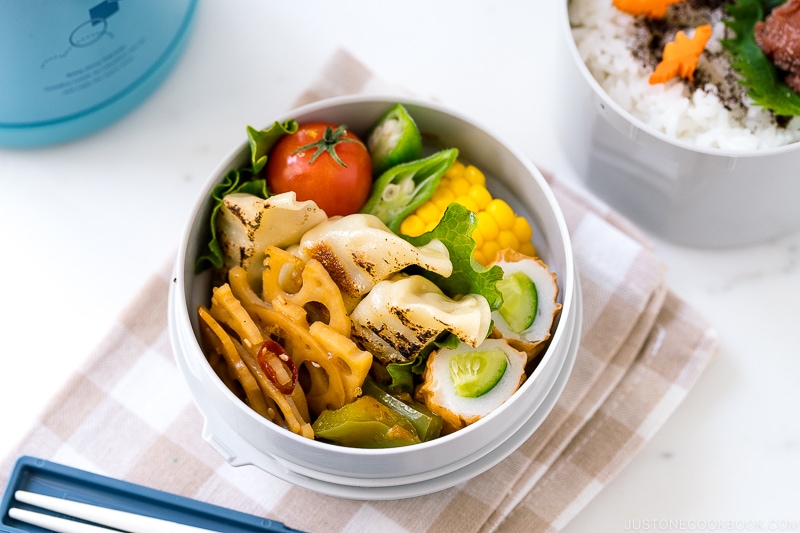
- Carbs: Steamed Rice (frozen → reheat in the microwave) with yukari rice seasoning, shiso leaf, and umeboshi
- Main: Frozen store-bought gyoza (pan-fried in the morning)
- Sides: Kinpira Renkon (frozen → thaw in fridge overnight), green bell pepper with okaka (frozen → thaw in bento box)
- Fillers: Chikuwa Cucumber (freshly made in the morning), blanched okra (refrigerated), boiled corn (frozen → thaw in bento box), cherry tomato
- Fruits: In another container
Bonus/Saturday: Mapo Tofu Bento
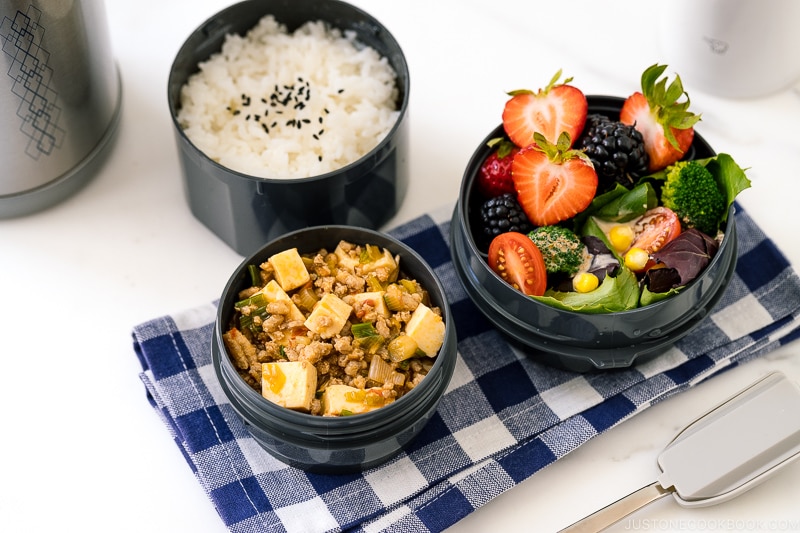
- Carbs: Steamed Rice (frozen → reheat in the microwave) with black sesame seeds
- Main: Mapo Tofu (leftover → reheat in the microwave)
- Sides: Salad with store-bought sesame dressing (put together in the morning)
- Fillers: Blanched broccoli (frozen → thaw in bento box), cherry tomato
- Fruits: Berries
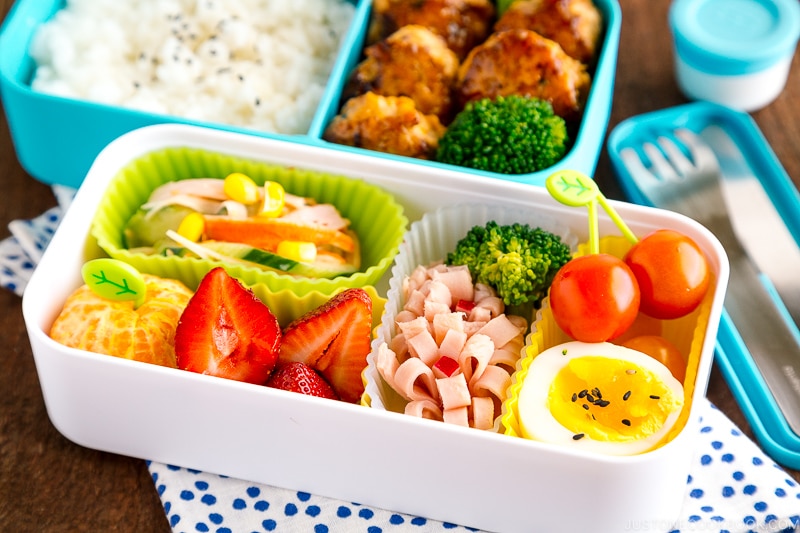
To Wrap Up: 5 Important Take Aways
I hope this tutorial will help to get you started. Here are 5 important takeaways.
- Plan 5 types of foods: Carbs, main, sides, fillers, and fruits.
- Make colorful lunches that your kids look forward to eating.
- Use leftover food from the previous dinner. Always keep in mind to make extra food and freeze.
- Stock up on meal-prepped dishes in the freezer for stress-free bento making! Utilize store-bought frozen food such as frozen gyoza in a pinch. Check and organize the inventory often and re-stock.
- Pack food tightly in the bento boxes to avoid shifting.
Don’t try to make a perfect bento. Start with 2 days a week and make sandwiches on the other 3 days!
Zojirushi Vacuum Insulated Lunch Jars Review
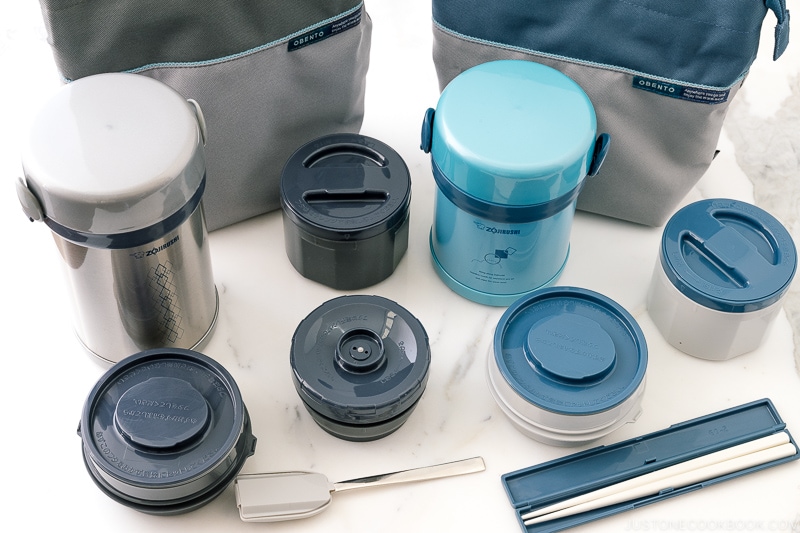
This post was sponsored by Zojirushi to feature two of the Zojirushi lunch jar series, which I’ve been using for my children. These cylinder lunch jars are slightly different from the typical bento boxes, but they are designed for the classic Japanese meal format.
- Ms. Bento® Stainless Lunch Jar SL-MEE07 (2 inner bowls)
- Ms. Bento® Stainless Lunch Jar SL-NCE09 (3 inner bowls)
Features
The features of Ms. Bento® Stainless Lunch Jar include:
- Durable stainless steel construction with excellent heat retention
- Its vacuum insulation keeps foods hot or cold for hours.
- Microwaveable inner bowls
- Washable nonstick-coated outer container
- Includes chopsticks/chopsticks holder (or forked spoon) and easy-to-carry tote bag
- Made of BPA-free plastic and stainless steel
The main difference between the two is one comes with 2 tiers and the other comes with 3 tiers which allows you to pack soup or hot food with gravy or sauce.
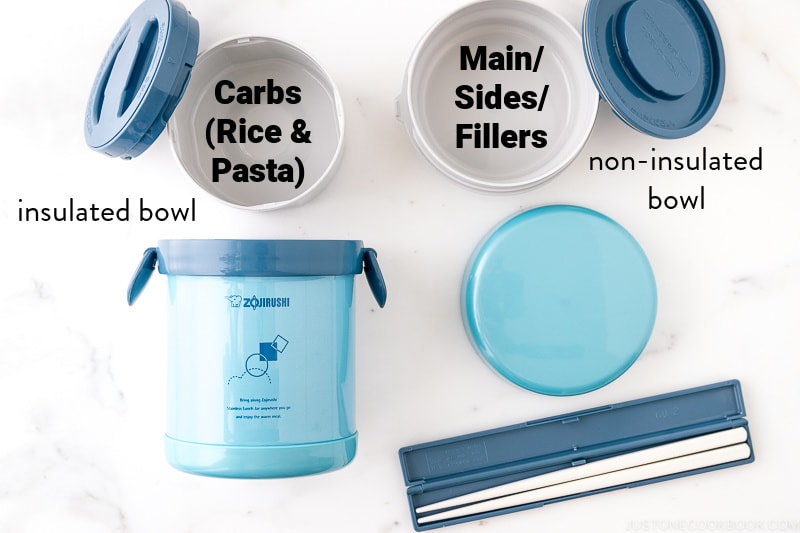
For Zojirushi Ms. Bento® Stainless Lunch Jar SL-MEE07 (2 inner bowls), pack the rice in the bottom insulated bowl, and the rest in the upper un-insulated bowl.
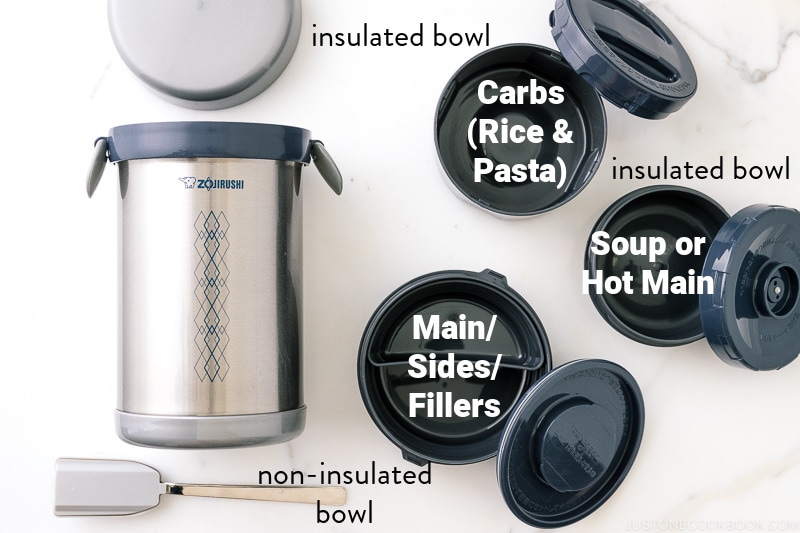
For Zojirushi Ms. Bento® Stainless Lunch Jar SL-NCE09 (3 inners bowls), pack your soup/ hot dish in the bottom insulated bowl, followed by rice (or other carbs) in the middle insulated bowl, then the other cold dishes in the top non-insulated bowl.
Our Honest Reviews (Me + The Kids)
I also asked my kids what they like and don’t like about these bento jars and here are our honest reviews:
Pros:
- Kids: It’s SO nice to eat warm food (especially warm rice)!
- Kids: I like that it’s packed nicely in one jar. Mom doesn’t have to pack in different size containers.
- Kids: My friends think my lunch is really cool.
- Mom: I don’t have to wait until the rice is cool before packing, so it saves time on prepping!
Cons:
- Kids: A bit heavier than other bento boxes but not a big deal.
- Mom: Hand wash only… but I don’t mind.
Useful Bento Resources on JOC
Basics
- The Ultimate Guide to Bento Box Lunch
- Food Safety Tips For Bento
- Frequently Asked Questions About Bento – Check this post if your question hasn’t been answered.
Helpful Tips
- How to Pack Bento in 15 Minutes
- How To Freeze Food for Bento
- Meal Prep Freezer-Friendly Bento Dishes
- Meal Prep Bento Recipes Ideas: 3 Dollar Bento Challenge
Menu Ideas
- Bento Menus for Inspiration
- Back to School Easy Bento Box Ideas
- Back to School Easy Bento Ideas & Recipes
- How to Make Cute Bento (Video)
Wish to learn more about Japanese cooking? Sign up for our free newsletter to receive cooking tips & recipe updates! And stay in touch with me on Facebook, Pinterest, YouTube, and Instagram.
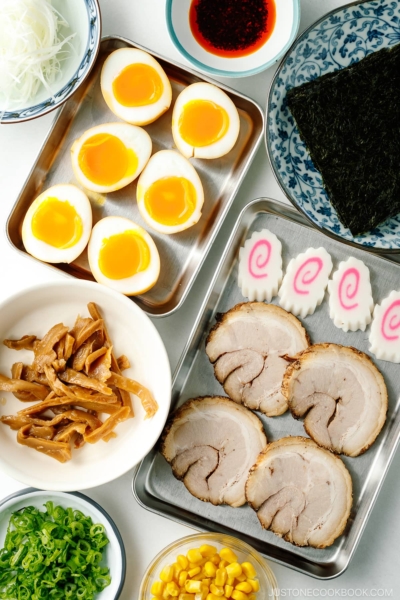
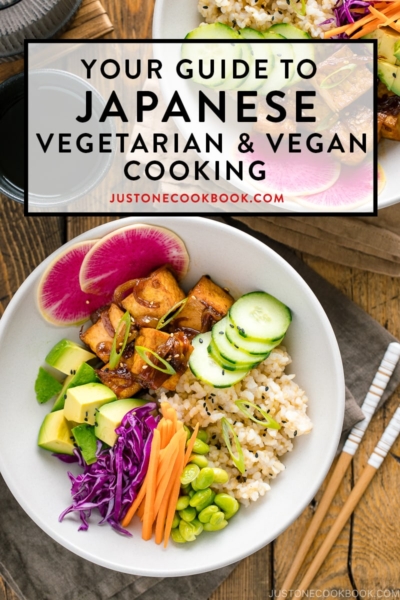
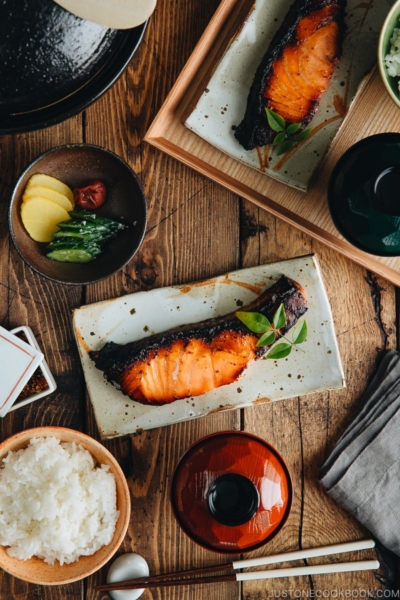
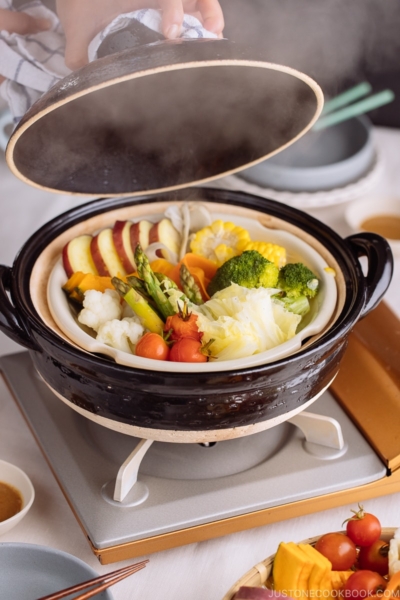




Hi Namko. Are bentos supposed to eat at room temperature? I suppose that’s why I see a lot of sewing tutorial for insulated lunch bags.
Hi, Trang. Thanks for reading Nami’s post!
Bentos were traditionally served at room temperature. Some schools and offices didn’t have microwaves to heat food.
Hopefully, this helps!
This so helpful, thank you! Can I ask: What store bought Gyoza do you buy?
Hello, Elizabeth! We’re delighted you found this content useful.☺️
Day-Lee Pride Umami Gyoza Dumplings are a favorite of Nami’s family. It is a frozen food that comes in a bag of 21 oz.
I bought one of these jars about 7 or 8 years ago and it’s still in perfect condition! I use it for work a few times a week. I live in Ireland so it was quite expensive at the time but honestly it’s lasted longer than anything else I’ve ever owned. Can’t wait to try some of these ideas!
Hi Carla! Awesome! We hope you enjoy Nami’s Bento ideas!
Thank you for reading Nami’s post and trying her recipes! 🤗
Hi Naomi,
Do you know if the zojiruchi bento box is bpa free? Thank you
Hello, Yenny. Thank you so much for taking the time to read Nami’s post.
According to the Zojirushi website, the product is BPA-free.
More information can be found at: https://shop.zojirushi.com/products/slnce
We hope this was helpful!
Hi Naomi,
Thank you so much for your tips and recipes! Just wanted to ask when packing main dish for the top non-insulated bowl (like teriyaki meatball or salmon), should the food be reheated and cooled down before closing the lid?
If I want the main dish warm, would you suggest I put them in with the rice? Thank you!
Hi, Annabel! Thank you so much for taking the time to read Nami’s post and try her bento recipes.
If the bento box is not insulated, we strongly advise reheating and cooling the food before closing the lid.
If you want to keep the main dish warm, pack it with rice in the insulated bowl or use 3 inner bowls Bento box.😊
We hope this was helpful!
wow Thank you for your wisdom and amazing ideas. Definitly going to try some of these.
Hi Dorothy! Awesome! We hope you enjoy making Bento!
Thank you for reading Nami’s post and for your kind feedback.😊
I love all your bento related posts, it makes my life so much easier! Today I brought udon on my bento for lunch and they were all stuck together. Is there any trick to pack unseasoned udon?
Hi Taís, Thank you very much for reading Nami’s bento posts and for your kind feedback!
When Udon gets cold, it tends to stick together, just like other pasta. It depends on the dish; you can add a bit of oil, rinse the noodle when you are ready to eat, or make it in a small bundle (see attached post photos) so that when you pick it up, it will just be stuck by small portion.
https://www.justonecookbook.com/somen/
We hope this helps!
These are great tips, thank you!
Hi Nami,
I just found this, and it has been very helpful, thank you! I just got the Zojirushi Ms. Bento (with 2 inner bowls only), and from the reviews some people were saying the top bowl also keeps things warm, but I didn’t think so? From the bento packing structure above, it seems like only the bottom bowl has the insulation to keep things warm, is this correct?
Thank you!
Meno
Hi Meno, Thank you very much for reading Nami’s post!
The bento box in this post’s top bowl holds food at room temperature and a non-insulated bowl. However, if someone placed the hot item and kept it, it might keep the things warmer but not warm. The only bottom bowls are insulated.🙂 We hope this helps!
HI Nami
Thank you for sharing this, I love this post as I find it useful. I am going to try out the various bento meals that you have shared! 🙂
I have a similar 3 layers thermal but i was told by the sales promoter to add in a little hot water before putting in the bowls to keep the food warm. Would it still be safe to put fresh fruits in the top non-insulated bowl? Thank you
Hi Jane! Thank you very much for reading Nami’s post and for your kind feedback!
This Ms. Bento box has a thick insulated lid to separate the lower bowl (insulated bowl) and upper bowl (non-insulated bowl). How about yours?
And Nami adds at least one item, that “frozen → thaw in bento box” item, to work as an ice pack inside the upper bowl.
We hope this idea helps!
nice post and good photos.
One of my key bento adds is a fridge pickle – the recipe below can be made in bulk and keeps for 3 weeks in the fridge
–
Recipe: All-season shredded vegetable pickle-saladMakes about 3 cups (4 cups of vegetables wilt down in volume when done)
Put the vegetables in a bowl and sprinkle on the salt. Massage the vegetables until the vegetables have wilted a bit.
Combine all the ingredients in a non-reactive (not metal) container with a tight fitting lid. Put the lid on and give it a good shake. Leave to marinate overnight before eating.
Not sure starting yout post with a promo for a vac flask was great.
Hi Peter, Thank you very much for reading Nami’s post and sharing your cooking experience and thought! 🙂
If you use the insulated jars will the hot or cold food stay at a safe temperature without cold packs or reheating the inner bowls?
Hi Johnson, Thank you very much for reading Nami’s post!
It depends on the type/brand of insulated jars. Good quality one should be able to keep Hot Foods Hot and Cold Foods Cold until lunchtime.
Bacteria grow most rapidly in the range of temperatures between 40 °F and 140 °F.
We hope this helps!
Great ideas! My daughter loves a hot lunch. We just bought the Omie box, but I think she’d love the lunch jars. Sometimes I send potstickers that are cold by lunchtime. I think I need to re-think my presentation. And I want to try your chicken teriyaki meatball recipe now. Thank you!
Hi Lauren! Thank you very much for reading Nami’s post and for your feedback!
We hope you enjoy many Bento recipes from our site.🙂
Dang, this is a really good tutorial. I still have a few years before my kid will be sent off with a pack lunch but this page makes it seems almost doable!
Hi Brent! We are glad to hear you found this post!
We hope you have many chances to try different Bento near future!🍱
Happy Cooking!